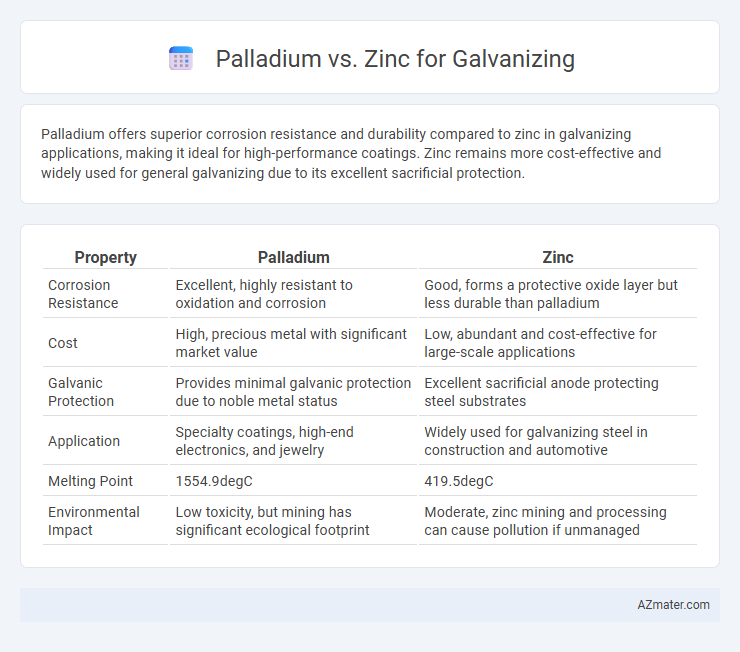Palladium offers superior corrosion resistance and durability compared to zinc in galvanizing applications, making it ideal for high-performance coatings. Zinc remains more cost-effective and widely used for general galvanizing due to its excellent sacrificial protection.
Table of Comparison
| Property | Palladium | Zinc |
|---|---|---|
| Corrosion Resistance | Excellent, highly resistant to oxidation and corrosion | Good, forms a protective oxide layer but less durable than palladium |
| Cost | High, precious metal with significant market value | Low, abundant and cost-effective for large-scale applications |
| Galvanic Protection | Provides minimal galvanic protection due to noble metal status | Excellent sacrificial anode protecting steel substrates |
| Application | Specialty coatings, high-end electronics, and jewelry | Widely used for galvanizing steel in construction and automotive |
| Melting Point | 1554.9degC | 419.5degC |
| Environmental Impact | Low toxicity, but mining has significant ecological footprint | Moderate, zinc mining and processing can cause pollution if unmanaged |
Introduction to Galvanizing: Purpose and Importance
Galvanizing involves coating steel or iron with a protective layer to prevent corrosion, significantly extending the lifespan of metal structures. Zinc is the most commonly used metal for galvanizing due to its excellent sacrificial properties and cost-effectiveness, forming a durable barrier against rust. Palladium, while less common, offers superior corrosion resistance and catalytic properties, making it ideal for specialized applications requiring enhanced durability and performance.
Overview of Palladium and Zinc in Metal Protection
Palladium, a rare noble metal, is highly valued for its exceptional corrosion resistance and catalytic properties in specialized metal protection applications. Zinc, widely used in galvanizing, forms a robust sacrificial coating that protects steel from rust through galvanic corrosion. While zinc is economically favored for large-scale corrosion prevention, palladium offers superior durability in harsh chemical environments but at a significantly higher cost.
Chemical Properties: Palladium vs Zinc
Palladium exhibits high chemical stability and resistance to oxidation, making it less reactive compared to zinc during galvanizing processes. Zinc, known for its excellent sacrificial anode properties, readily corrodes to protect underlying metals, forming a stable zinc oxide layer. The distinct chemical behaviors of palladium and zinc directly influence their effectiveness in galvanizing, with zinc's reactivity providing superior corrosion resistance in steel protection.
Corrosion Resistance Comparison
Palladium offers superior corrosion resistance compared to zinc due to its inertness and ability to form stable, protective oxide layers, making it highly effective in harsh environments and acidic conditions. Zinc provides sacrificial protection by corroding preferentially, which is beneficial in many applications but results in shorter lifespan under aggressive exposures. Choosing between palladium and zinc for galvanizing depends on the specific environmental conditions and the desired durability, with palladium preferred for long-term resistance and zinc favored for cost-effective, general-purpose protection.
Galvanizing Process Differences
The galvanizing process for zinc involves hot-dip immersion in molten zinc, creating a durable zinc-iron alloy coating that protects steel from corrosion. Palladium galvanizing typically uses electroplating techniques, applying a thin, uniform palladium layer that offers superior resistance to oxidation and chemical exposure. Zinc coatings excel in sacrificial protection and are cost-effective, while palladium coatings provide enhanced durability and aesthetic appeal in specialized applications.
Cost Analysis: Palladium vs Zinc
Zinc remains the preferred and cost-effective choice for galvanizing due to its abundant availability and lower price per kilogram compared to palladium, whose high market value significantly increases overall expenses. Palladium's rarity and demand in electronics and catalytic converters drive its cost substantially higher, making it economically impractical for large-scale galvanizing applications. Companies typically opt for zinc coatings to balance corrosion resistance with budget constraints, as zinc plating costs are consistently lower than palladium alternatives.
Environmental Impact and Sustainability
Palladium offers superior corrosion resistance in galvanizing processes but is scarce and energy-intensive to extract, leading to a higher environmental footprint compared to zinc. Zinc is abundant, recyclable, and has established eco-friendly galvanizing practices that minimize pollution and resource depletion. Sustainable galvanizing favors zinc due to its lower environmental impact, cost-effectiveness, and wide availability for large-scale industrial use.
Industry Applications and Use Cases
Palladium is primarily used in high-performance catalytic converters and electronic components due to its exceptional corrosion resistance and catalytic properties, making it essential in automotive and electronics industries. Zinc, widely employed in galvanizing steel, offers cost-effective corrosion protection by forming a robust sacrificial barrier, essential for construction, automotive body panels, and infrastructure projects. While palladium is favored for specialized, high-value applications requiring chemical stability, zinc is the industry standard for large-scale protective coatings in industrial manufacturing and heavy-duty environments.
Lifespan and Maintenance Requirements
Palladium coatings exhibit superior corrosion resistance compared to zinc, resulting in a longer lifespan for galvanized steel components, often exceeding 30 years under harsh environmental conditions. Zinc remains the standard for galvanizing due to its cost-effectiveness, but it typically requires more frequent maintenance or reapplication every 10-15 years to prevent rust. The enhanced durability of palladium reduces maintenance intervals and lifecycle costs, making it ideal for critical infrastructure exposed to aggressive corrosive environments.
Final Verdict: Choosing the Right Metal for Galvanizing
Palladium offers superior corrosion resistance and durability compared to zinc, making it ideal for high-performance galvanizing applications in harsh environments. Zinc remains the cost-effective choice for general galvanizing needs, providing adequate protection in less aggressive conditions with excellent sacrificial anode properties. Selecting the right metal depends on balancing budget constraints with required longevity, where palladium suits long-term, critical projects and zinc fits standard, economical coatings.

Infographic: Palladium vs Zinc for Galvanizing
 azmater.com
azmater.com